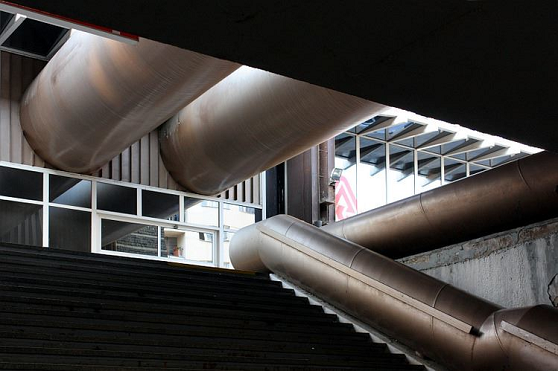
The Transgas buildings will not be a monument, and the owner can demolish them
Publisher
ČTK
21.11.2017 13:00
ČTK
21.11.2017 13:00
Czech Republic
Prague
Václav Aulický
Jiří Eisenreich
Ivo Loos
Jindřich Malátek
 |
Prague - The Transgas building complex on Vinohradská Street in Prague will not be declared a cultural monument. Its owner, who wants to build new houses on the site, can demolish them. Referring to a decision by the Ministry of Culture, Hospodářské noviny and Právo reported this today. However, the decision to halt the review process has not yet been delivered to all participants in the proceedings, and the ministry did not want to comment on the inquiry from ČTK.
Last week, the Club for Old Prague reported on its website that Minister Daniel Herman (KDU-ČSL) had stopped the review process, thus also suspending the temporary monument protection of the buildings. The club was the initiator of the proposal to declare the structures from the 1970s as a monument. The minister's decision, which is available on the website, states that among other things, the properties are inappropriately integrated into the surroundings, "the details of the buildings, facades, and railings are beyond human scale", that there has been "no significant cultural-historical event" in the area, or that the buildings are not, unlike the Ingstav or Kotva building, significant examples of brutalism. "The authors of the properties tried to imitate Western models, but with very controversial results," reads the decision.
Declaring architecture from the second half of the 20th century as monuments is often controversial, but it is the only option in current legislation to save the buildings from destruction. However, there is no unified opinion even among experts regarding 20th-century architecture; some would protect it unconditionally, others selectively, while some argue that due to the technologies used at the time, it is no longer usable today.
Last year, the Ministry of Culture refused to declare the buildings above the National Museum as a monument; Herman began reviewing his officials' decision in the spring. At the end of September, he stated in the media that the review committee recommended reassessing the office's approach, noting that Transgas should be preserved.
The investor, HB Reavis, reacted sharply at that time and criticized the minister for presuming the outcome of the proceedings. The investor stated that he sees the review merely as an examination to determine whether any procedural errors occurred. According to him, any damage that may have arisen has already exceeded half a billion crowns.
An example of a case where the Ministry of Culture did not declare a house as a monument after the investor threatened with a lawsuit for lost profits is the building at the corner of Wenceslas Square and Opletalova Street. This summer, after the Ministry of Culture had previously refused to grant it monument protection under different leadership, it was demolished.
When the Ministry of Culture considered the proposal to declare Transgas a monument last year, the National Heritage Institute (NPÚ) via its office in Prague did not recommend the declaration. It stated that "the complex does not create an urban environment and, in terms of mass and scale, damages the environment of the urban conservation zone". The Ministry of Culture did not declare it a monument. However, in the proposal to initiate a review, the General Directorate of the NPÚ supported the declaration and communicated this to the minister.
The Transgas complex, formerly the Central Gas Dispatching and the Ministry of Fuel and Energy, is the work of the team Jindřich Malátek, Ivo Loos, Zdeněk Eisenreich, and Václav Aulický. The authors of the proposal to declare the buildings as a monument view them as an outstanding example of stylistically synthetic architecture from the 1970s, combining elements of brutalism, technicism, and postmodernism, but also as a unique realization of postmodern urbanism in Czech territory.
The English translation is powered by AI tool. Switch to Czech to view the original text source.
Related articles
9
26.02.2024 | At the site of the former Transgas in Prague, construction could begin in the summer of 2025
1
02.12.2019 | Developer will not sell the land after Transgas, wants to build again himself
0
18.02.2019 | Preparatory work necessary for the demolition of Transgas has begun
0
14.01.2019 | The Building Office of Prague 2 has approved the demolition of the Transgas building complex
0
14.11.2018 | Znojmo this year replaced the windows in the Loucký Monastery for 4.7 million
1
16.08.2018 | The building authority will decide on the demolition of Transgas no earlier than a week from now
1
02.08.2018 | Experts are urging authorities not to permit the demolition of the Transgas buildings
13
26.07.2018 | The owner of the Transgas buildings in Prague has requested their demolition
3
04.12.2017 | Na 160 lidí protestovalo proti demolici budov Transgasu translates to About 160 people protested against the demolition of the Transgas buildings
1
03.12.2017 | SOS Transgas: protest against demolition
10
21.11.2017 | The buildings of Transgas are among the most distinctive structures from the 1970s in Prague
0
01.10.2017 | The fate of Transgas will probably not be decided before the elections
1
10.05.2017 | Herman initiated a review of the decision regarding Transgas, it cannot be demolished
0
03.04.2017 | The ministry could decide on the fate of Transgas in about a month
0
30.01.2017 | Experts want to protect Transgas, the author of the building is against demolition
2
23.01.2017 | Historians want to save Transgas, they ask the minister for help
0
17.03.2016 | The ugliest architecture in Prague - Transgas Building











